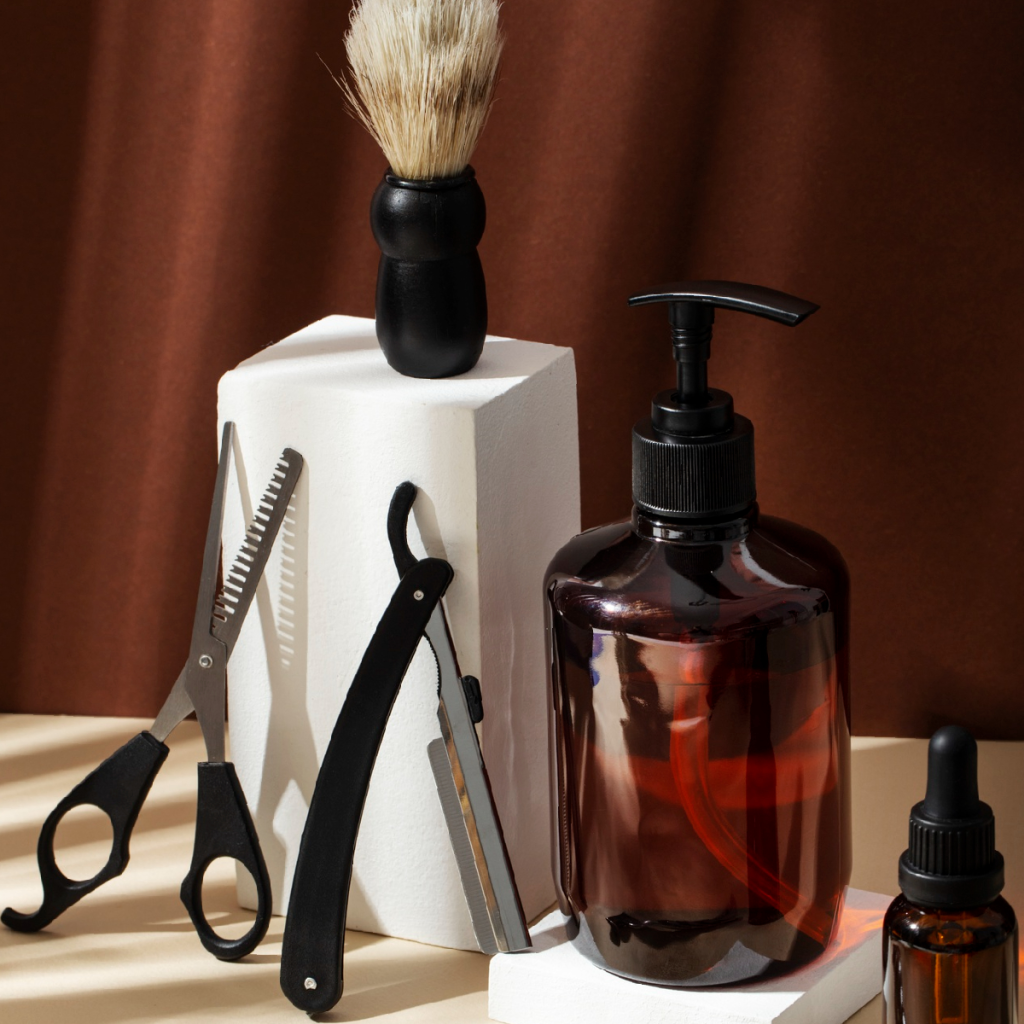Discover the key differences between trimming curly hair and trimming straight hair.
How Does Trimming Curly Hair Differ from Trimming Straight Hair?
Curly hair and straight hair may look different, but they also require different approaches when it comes to trimming. Understanding the unique characteristics of each hair texture is essential to achieving the best results. So, let’s dive into the science behind hair textures and explore the art of trimming curly and straight hair!

Understanding Hair Textures
Before we delve into the specifics of trimming curly and straight hair, let’s take a moment to understand the fascinating science behind these different hair textures.
The Science Behind Curly and Straight Hair
Curly hair and straight hair have distinct structural differences. Curly hair typically has a more elliptical shape, while straight hair tends to be round. These variations in shape are due to the amount and structure of the protein called keratin in each hair strand.
But it’s not just about shape — the number of cuticle layers also differs between curly and straight hair. Curly hair usually has a higher number of cuticle layers, which makes it more prone to frizz and breakage.
Additionally, the diameter of the hair shaft varies between curly and straight hair. Curly hair tends to have a smaller diameter, making it more susceptible to damage from heat styling tools and chemical treatments.
Furthermore, the sebaceous glands, which produce natural oils that moisturize the hair, are more active in straight hair compared to curly hair. This difference in oil production affects the overall moisture level and texture of the hair.
Moreover, the arrangement of keratin proteins within the hair shaft also contributes to the unique characteristics of curly and straight hair. In curly hair, the proteins are arranged in a spiral pattern, creating the distinctive curls. In straight hair, the proteins align in a more linear fashion, resulting in the sleek appearance.
So, armed with this knowledge, let’s explore how these unique characteristics influence the way we trim curly and straight hair.
The Art of Trimming Curly Hair
Ah, curly hair, a glorious crown of natural beauty! But it requires some special care, especially when it comes to trimming. Let’s dive deeper into the world of curly hair trimming and explore why it’s essential, the techniques to master, and the common mistakes to avoid.
Why Regular Trims are Essential for Curly Hair
The first rule of maintaining curly hair is regular trimming. Curly hair tends to be more prone to split ends, and the occasional trim helps prevent breakage and maintain the shape of those lovely curls. But why is that?
Curly hair has a unique structure that makes it more susceptible to damage. The twists and turns of each strand can create friction, leading to split ends and frizz. Regular trims help to remove these damaged ends, keeping your curls healthy and vibrant.
When it comes to frequency, aim for a trim every 8-12 weeks. This prevents those sneaky split ends from creeping up and wreaking havoc on your curly locks. It’s all about finding the balance between maintaining length and ensuring the overall health of your hair.
Techniques for Trimming Curly Hair
Trimming curly hair requires a delicate touch and a keen eye for detail. Here are a few techniques to keep in mind:
- Snip, snip!: Use sharp, professional-grade scissors to make clean cuts. Blunt or dull scissors can cause fraying, and we definitely don’t want that! Investing in a good pair of scissors specifically designed for hair trimming will make a world of difference.
- Embrace the dry trim: Unlike straight hair, curly hair is best trimmed when dry. This allows you to see the natural shape and prevent any unwanted surprises when those curls spring up. Wet hair can appear longer and may lead to cutting more than intended.
- Tackle those split ends: Focus on trimming individual split ends instead of taking big chunks off. This method helps preserve the natural texture and prevents choppy results. Take your time and work section by section, ensuring each split end is carefully snipped away.
Common Mistakes to Avoid When Trimming Curly Hair
Now that we’ve covered the proper techniques, let’s talk about some common mistakes to steer clear of:
- The overzealous trim: While regular trims are essential, going overboard can lead to excessive length loss. Just a dusting is usually enough to maintain those luscious curls. Remember, less is more!
- Pulling straight: Remember, don’t stretch out the curls when trimming! Cutting the hair while it’s stretched can result in uneven lengths when it springs back up. Embrace the natural shape of your curls and trim accordingly.
- Ignoring shape: Curly hair has a unique structure, and trimming should be done to enhance its natural form. Don’t be afraid to consult a professional stylist for guidance on achieving the perfect shape. They can tailor the trim to suit your specific curl pattern and help you embrace your hair’s natural beauty.
So, the next time you find yourself in need of a trim, remember these tips and techniques to keep your curly hair looking its best. Regular trims, done with care and precision, will help you maintain healthy, bouncy curls that are the envy of all!
The Process of Trimming Straight Hair
Straight hair, oh so sleek and shiny! While it might seem easier to trim compared to its curly counterpart, there are still some essential steps to follow for maintaining those straight strands.
When it comes to straight hair, regular trims are just as important as they are for curly hair. Although straight hair is not as prone to split ends, regular trims are necessary to maintain its healthy appearance. Trimming every 8-12 weeks helps prevent split ends from traveling up the hair shaft and keeps your locks looking fresh.
Trimming straight hair requires precision and attention to detail. Here are some tried-and-true techniques to achieve the perfect trim:
- Start with clean, dry hair: Trimming straight hair when it’s clean and dry allows for better accuracy. Wet hair can sometimes appear longer, leading to uneven trims. So, make sure to wash and dry your hair before getting started.
- Section it up: Divide your hair into manageable sections to ensure an even trim. This technique not only helps in achieving a uniform cut but also allows you to focus on specific areas that may require more attention. Use clips or hair ties to separate your hair into sections, making the trimming process easier and more efficient.
- Follow the guide: If you have a preferred length or style, use it as a guide for your trim. By following a guide, you can maintain consistency and achieve the desired look. Whether it’s a specific length or a particular style, having a reference point will help you achieve the haircut you desire.
Even with straight hair, there are a few common mistakes to avoid during the trimming process:
- Going crooked: Uneven cuts are a no-no! Take your time and make small, intentional snips to ensure a straight and uniform trim. It’s better to make multiple small adjustments than to make one big mistake that could ruin your haircut.
- Taking off too much: We’ve all been there — the temptation to go for a dramatic chop. But unless you’re aiming for a major change, it’s best to stick to a conservative trim to maintain length and health. Remember, hair takes time to grow, so be mindful of how much you’re cutting off.
- Relying solely on home remedies: While DIY trims can be convenient, it’s always a good idea to seek professional help from a reputable hairstylist. They have the expertise to handle any unexpected challenges and offer personalized advice. A professional hairstylist can also provide guidance on the best techniques and tools to use for your specific hair type and desired style.
So, the next time you find yourself in need of a trim for your straight hair, remember these tips and techniques to achieve a flawless and healthy look. Whether you choose to do it yourself or seek professional help, regular trims will keep your straight locks looking sleek and shiny.
Tools and Products for Different Hair Textures
Now that we’ve covered the techniques for trimming curly and straight hair, let’s talk about the tools and products that can enhance your trimming experience and keep your locks looking fabulous!

When it comes to trimming curly hair, these tools are must-haves:
- Sharp hair shears: Invest in a quality pair of scissors specifically designed for cutting hair. Trust us, your curls will thank you!
- Wide-toothed comb: Curly hair can be prone to tangling, so a wide-toothed comb helps detangle gently without causing damage.
- Mirror with good lighting: A clear view of your gorgeous curls while trimming is crucial. Make sure you have proper lighting and a mirror to guide your handiwork.
Trimming curly hair requires special attention and care. The unique texture of curly hair demands precision and the right tools. Using sharp hair shears ensures clean cuts that minimize frizz and maintain the shape of your curls. The wide-toothed comb is a curly-haired individual’s best friend, as it helps detangle without causing breakage or disrupting the natural curl pattern. And let’s not forget the importance of good lighting and a mirror. Seeing your curls clearly allows you to trim with confidence, ensuring that you achieve the desired results.
For those with straight hair, these tools will come in handy during your trimming sessions:
- Sharp hair-cutting scissors: The key to a successful trim lies in the precision of your scissors. Look for professional-grade shears to achieve that perfect cut.
- Fine-toothed comb: Straight hair benefits from a fine-toothed comb, which helps create precise parts and ensures an even trim.
- Handheld mirror: Having a handheld mirror allows you to inspect your hair from multiple angles to catch any missed spots.
Trimming straight hair requires a different set of tools compared to curly hair. The sharp hair-cutting scissors are essential for achieving clean and precise cuts. Opting for professional-grade shears ensures that you have the necessary sharpness and accuracy to maintain the sleekness of your straight locks. A fine-toothed comb is ideal for straight hair, as it helps create defined parts and ensures an even trim. Additionally, a handheld mirror becomes a valuable tool, allowing you to assess your hair from different angles and make sure you haven’t missed any areas that need trimming.
After every trim, it’s essential to give your hair some extra love and care. Here are a few recommended products:
- Leave-in conditioner: Hydrate those beautiful curls with a leave-in conditioner designed specifically for curly hair. This helps combat frizz and keeps your curls healthy.
- Heat protectant spray: If you’re using heat styling tools, protect your hair from damage with a heat protectant spray. This ensures your straight strands remain sleek and healthy.
- Hair oil: Nourish and add shine to your locks with a lightweight hair oil. Apply a few drops to the ends to combat dryness and prevent split ends.
After trimming your hair, it’s important to provide it with the necessary nourishment and protection. For curly hair, a leave-in conditioner specifically formulated for curls is a game-changer. It helps hydrate and moisturize your curls, combating frizz and promoting overall hair health. Straight hair, on the other hand, benefits from a heat protectant spray when using heat styling tools. This spray acts as a shield, preventing damage and maintaining the sleekness of your straight strands. Regardless of your hair texture, using a lightweight hair oil can work wonders. It nourishes your locks, adds shine, and prevents dryness and split ends.
Now that you’re armed with the knowledge of how trimming curly hair differs from trimming straight hair, go forth and embrace the art of giving your hair the love and maintenance it deserves!





